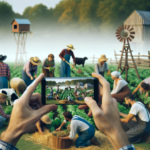Introduction to Photography for Marketing
Have you ever wondered how visuals can significantly improve your marketing efforts? Or how high-quality images can boost engagement and convey your brand’s message effectively?
Look no further, because we’ll be covering this and so much more in this article.
We’ll walk you through various sections ranging from how good photography enhances professionalism, supports social media strategies, and improves SEO results to the art of telling your brand’s story through imagery.
There’s more!
We will also be discussing the importance of photography in specific settings like a farmers market and the necessary gimmicks to make your images top-notch.
Whether you’re a professional marketer, a small business owner looking to scale up, or simply fascinated by the power of visuals, this article has something for everyone. Let’s start exploring this enlightening venture!
Table of Contents
Why Photography is Important for Marketing
Boosting Engagement and Attraction
Good photography can significantly enhance your marketing efforts. High-quality images grab attention immediately. They help convey your brand’s message quickly.
- Visual content is processed 60,000 times faster than text.
- People remember 80% of what they see and only 20% of what they read.
Enhancing Professionalism
Using professional photography ensures that your brand looks trustworthy and competent. Poor quality images can harm your credibility.
| Image Quality | Impact on Perception |
|---|---|
| High-Quality | Professional, Trustworthy |
| Low-Quality | Unprofessional, Incompetent |
Supporting Social Media Strategies
Images are indispensable for social media marketing. Platforms like Instagram and Pinterest rely exclusively on visuals. Facebook posts with images see higher engagement rates.
Visuals in Content Marketing show that posts with images get 2.3 times more engagement.
Improving SEO Results
Good photos can also boost your website’s SEO. Alt tags and image descriptions are essential for search engine indexing. This practice drives more organic traffic to your site.
- Include relevant keywords in image descriptions.
- Ensure images are properly compressed and do not slow down your site.
Telling Your Brand’s Story
Photos allow you to tell your brand’s story more effectively. Images can capture emotions and experiences better than words.
- Use photos to illustrate your brand values.
- Showcase customer testimonials and real-life usage of your products.
Essentials for Farmers Market Photography
Taking Advantage of Natural Light
One thing that sets apart outdoor photography, like at a farmers market, is the availability of natural light. It is known to result in high-quality images that maintain the true colors of your subject.
- Depending on the weather, adjust the camera settings to avoid overexposure or underexposure.
- Try to schedule your photo shoot in the early morning or late afternoon for the best light conditions, known as the golden hours.
Framing and Composing Your Shot
Capturing the vibrancy of a farmers market involves more than just clicking a button. Here’s where knowledge about different photography techniques comes into play.
| Techniques | Benefit |
|---|---|
| Rule of Thirds | Allows more balanced and engaging picture |
| Leading Lines | Draws viewers’ attention to the subject |
| Portrait Mode | Create the blur effect and focus more on the product |
Digital Photography School has an array of resources if you want to expand your knowledge about composition methods.
Utilizing Close-ups and Details
Close-ups can showcase the quality of the products available in the market. Capture textures and details of fresh produce, handmade items, or artisanal products.
- Use the macro mode for an effective close-up shot.
- Showcase unique details to portray the uniqueness of the market or product.
Capturing Candid Moments
People are an essential element of a farmers market. Interactions between stall owners and customers or the bustling crowd bring life to the market.
- Capture candid photos from different angles to show the market’s liveliness.
- Include various activities and interactions in pictures to display the market’s environment.
Consistency in Style and Theme
Keeping a consistent style helps establish your brand identity. You can achieve this through editing and post-processing.
- Stick to a color theme that matches your brand.
- Keep the editing style consistent across all pictures.
Essential Gear for Market Photography
Choosing the Right Camera
Selecting the appropriate camera is paramount for capturing market scenes effectively. While smartphones can take decent photos, a good DSLR or mirrorless camera provides enhanced quality and control.
- Consider cameras with high resolution for detailed shots.
- Look for features like fast autofocus and good low-light performance.
Lens Selection
Choosing the correct lens can make a significant difference in your market photography. Different lenses offer various advantages for capturing diverse scenes.
| Lens Type | Use Case |
|---|---|
| Wide-angle | Capturing broad scenes and market overviews |
| Prime | High-quality, detailed shots of products |
| Telephoto | Close-ups from a distance without disturbing the scene |
Tripods and Stabilizers
Stability is essential for sharp, high-quality images. Tripods and stabilizers help keep your camera steady, which is especially useful in low-light conditions or for detailed shots.
- Lightweight tripods are easy to carry around the market.
- A handheld stabilizer can help with smoother videos if you’re capturing market activities.
Editing and Post-Processing
Software for Photo Editing
Effective editing can enhance your market photos, making them look professional and appealing. Various software options are available to suit different skill levels.
- Adobe Photoshop is a powerful option for in-depth photo edits.
- Lightroom provides comprehensive tools for batch editing and organization.
- Free options like GIMP and Canva offer basic to moderate editing capabilities.
Editing Techniques
Specific editing techniques can help highlight the best aspects of your market photos. Consistency in editing ensures a unified visual identity for your brand.
- Adjust exposure and contrast to enhance the photo’s clarity.
- Use sharpening tools to bring out details in close-up shots.
- Apply color corrections to ensure the colors in your photos are true to life.
Maintaining Authenticity
While editing, it’s essential to maintain the authenticity of the scene. Over-editing can make photos look artificial and untrustworthy.
- Avoid excessive use of filters that drastically change the image.
- Maintain the natural colors of products and scenes.
Legal and Essential Considerations
Getting Consent for Photos
When photographing people at the market, it’s important to obtain their consent. This respect for privacy builds trust and complies with legal standards.
- Ask permission before taking close-up shots of individuals.
- Explain how the photos will be used and seek written consent if necessary.
Respecting Cultural Sensitivities
Markets often feature vendors and customers from diverse backgrounds. Being aware of cultural sensitivities is important to avoid offending anyone.
- Be mindful of specific market practices and traditions.
- Respect people’s preferences if they decline to be photographed.
Creating a Market Photography Plan
Storyboarding Your Shoot
A structured plan can help you cover all essential aspects of the market efficiently. Storyboarding allows you to visualize the shots you want to capture.
- Outline the key scenes and interactions you want to photograph.
- Plan the sequence of your photo session for smooth execution.
Time Management
Efficient time management ensures you make the most out of your photo session at the market. Prioritize key moments and scenes.
- Allocate more time to elements that need detailed engagement, like close-ups.
- Schedule ample time to cover different market sections and activities.
By using these tips and strategies, you can capture vibrant, engaging photos that truly represent the lively environment of a market.
How to Do Photography for Advertising
Understanding the Target Audience
Before you even pick up your camera, it’s vital to understand who you’re targeting with your advertising photography. Different audiences will respond to different types of images.
- Identify demographic details such as age, gender, and interests.
- Understand what kind of visual content resonates with them—whether it’s emotional, humorous, or informative.
Concept Development and Planning
An effective advertisement starts with a strong concept. Your photo should convey a clear message aligned with your brand’s objectives.
- Create a mood board with ideas and inspirations.
- Sketch out your shot list and storyboards.
- Plan your shoot location, props, and personnel in advance.
Lighting Setup
Good lighting can make or break a photo. In advertising photography, lighting is used to highlight the features of the product and create a mood.
- Use soft lighting for a natural look, typically achieved with diffusers.
- Experiment with high-key and low-key lighting to convey different moods.
- Consider the position of your light sources to avoid unwanted shadows.
Composition Techniques
Effective composition can draw attention to your product and make your advertising more impactful.
| Technique | Application |
|---|---|
| Symmetry | Creates a balanced and harmonious image |
| Negative Space | Highlights the subject by using empty space |
| Depth of Field | Focuses on the product while blurring the background |
Post-Processing for Advertisements
Editing is crucial to make sure your photos are polished and professional. Specific tweaks can help your images stand out.
- Adjust color correction to make your product pop.
- Use retouching tools to refine any imperfections.
- Overlay text or graphics that align with your brand’s aesthetics.
Legal and Ethical Considerations
Advertising photography is not just about aesthetics; legality and ethics are essential.
- Obtain model releases for any recognizable individuals in your photos.
- Ensure that your photos do not infringe on copyrighted materials.
- Be truthful in your representation to avoid misleading advertising.
Conclusion: The Power of Photography in Marketing and How to Leverage It
In sum, photography’s role in marketing cannot be overstated. High-quality photographs enhance brand professionalism, facilitate social media engagement, improve SEO indexing, and visually narrate a brand’s narrative. Moreover, the use of specific photography techniques at events like farmers markets can further equip marketers with effective visual tools.
Apart from practical techniques and gear selections, it’s also critical to focus on essential considerations such as obtaining consent for photos and respecting cultural sensitivities. Lastly, solidifying one’s grasp on photography within advertising contexts requires a strong understanding of the target audience, meticulous concept development, intelligent lighting setup, and conscientious post-processing.
By adhering to these guidelines, you should be well-equipped to optimize your marketing efforts through the power of photography.
Frequently Asked Questions – FAQs
Why is photography important in marketing?
Photography is important in marketing as it enhances brand professionalism, aids in social media engagement, improves SEO ranking, and helps narrate a brand’s story. People process and recall visual information faster and better than text.
What are some techniques to optimize market photography?
Some effective techniques include taking advantage of natural light, composing shots intelligently, capturing candid moments and details through close-ups, and maintaining consistency in style and theme. Utilizing appropriate gear and post-processing can also play a significant role.
What factors need considering when doing photography for advertising?
Understanding the target audience, developing a strong concept, setting up effective lighting, employing compelling composition techniques, and thoughtful post-processing are critical. Legal and ethical considerations also play a significant role.






